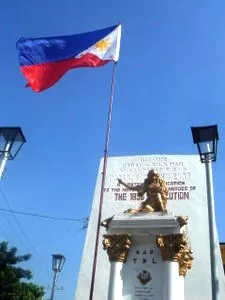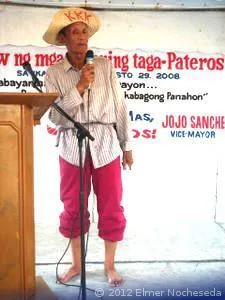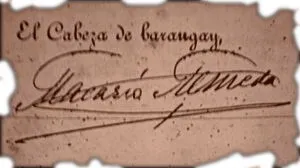The Pateros 1896 Revolution
by: Elmer Nocheseda
Founding the Balangay Magtanggol of Pateros
Macario Almeda or Cabesang Cario (b. 1867) is a farmer who, at the age of 29, was the youngest Cabeza de Barangay of Cabeceria No. 9 in 1896. He is married to Apolinia “Poleng” Calingo, with whom he had a son named Eugenio (b 1893). He is the headman of his sacopes of 83 tributantes, or tax payers, and 133 almas, or inhabitants.

He assumed the sagisag of Kidlat when he joined the Katipunan in 1896. He was elected as the Pangulo or the commander of the Pateros chapter called Sangguniang Balangay Magtanggol when the Katipunan was organized in the house of Angel Francisco in barrio Sto. Rosario in April 1896. Vicente Candichoy (alias Maningas) was elected Vice President and Marcos Lozada (alias Bakal) as Secretary. Hipolito Francisco (alias Lumaya) acted as Treasurer while Buenaventura Morcilla (alias Mabalasik), who was the Juez de Paz of Pateros, became the Punong Kawal or the military chief.
They also established two local chapters, or Sanguniang Nayon, in barrio Sta. Ana headed by Alejandro Santos (alias Apoy), and in barrio Aguho headed by Vicente Candichoy. It is said that by August of 1896 the Katipunan members in Pateros reached a total of 1,200 members.
Preparing for the Revolution
With the premature discovery of the secret activities of the Katipunan in August 19, 1896, they received the first warning of the impending armed struggle from the Kataastaasang Sanggunian of Andres Bonifacio on Saturday, August 22, 1896. The approximate significance of the order was the launching of the intense secret preparations for the attack of Intramuros, Manila which they have set on the midnight of August 29, the following Saturday. However, they were warned not to start the uprising prematurely till after the receipt of the second order of battle.
After six days of intense waiting, the final order of battle came from Supremo Andres Bonifacio at 12:00 noon of Saturday, August 29, 1896. The order was brought by General Vicente Leyba alias Kalentong of Mandaluyong. The orders were received by Ignacio Quiogue alias Tulos who is the Sugong Kinatawan or the authorized representative of the Balangay Magtanggol to receive the directives. This order was thereupon entrusted to the courier Angel Sacramento alias Mulawin who went around the members of the Katipunan to inform them of the planned uprising. On midnight of Saturday, August 29, 1896, the concentrated and simultaneous attack of Manila would proceed as previously planned.

As early as the nights of August 27 and 28, the feverish work on the manufacture of weapons for war in the various foundry shops has already begun in Pateros. They manufactured talibong, the long bladed weapon, in the foundries of Isaac Calderon in Barrio Kabaong and Sto. Rosario ; Alejandro Santos in Sta. Ana and Dulumbayan ; a man named Panta in Malaking Kahoy ; Francisco Santos alias Iskong Bulag for Subay or Ibayong Aguho ; Cenon Flores, Jacinto Flores, and Jacinto Asa for Lungos ; and Simeon Lubi and his brother in the bamboo grove of an old woman named Tandang Luisa Buenaflor.
The Katipuneros were wearing their uniform of sinamay a rayas, or sinamay shirt with red or blue strife, a buri hat, and red pants.
The August 29, 1896 Revolution
On the morning of August 29, the whole town of Pateros was deathly silent. Tension filled the air. Even the sky was overcast. It almost forebodes the shadow of death to the terror-stricken inhabitants. The Augustinian Spanish priest assigned in Pateros, Fray Tomas Espejo, somehow, obtained some knowledge of the imminent uprising. At around 2 pm, he ordered the Gobernadorcillo, or town mayor, Anacleto de Borja to post cuadrilleros, or town police, to guard the town entrance for the possible entry of bandits, or tulisanes, who were reported to have encamped in Novaliches. At 3 pm, Matias Cruz, a guard in the tribunal, prepared his gun, not as a police, but as a Katipunero joining the uprising. He went around town to convince his fellow guards to join the Katipunan.
At around 10:00 pm of August 29, Dr. Pio Valenzuela and Santiago Artiaga, the emissaries of Andres Bonifacio arrived in Pateros to see the preparations for the planned uprising. They were received in the brick house of Vicente Candichoy in Aguho where they confirmed the final details of the uprising.
It was a dark night with occasional heavy rains. The fields were wet and flooded with water because August was the height of the rainy season with much rains and typhoons. That made it more difficult for the movement and coordination of the Katipuneros.

Macario Almeda ordered Buenaventura Morcilla to deploy a body of soldiers to serve as blockade at the foot of Tulay na Bato on the road leading to Pasig. They were stationed near the store of Martin Ison, a former Capitan de Cuadrilleros, or captain of the local police. The main troops headed by the dual command of Alejandro T. Santos alias Kapitan Adyong, and Vicente Candichoy assaulted the Pateros Tribunal, or the municipal hall. The tribunal surrendered without a fight for the cuadrilleros or local policemen were secret members of the Katipunan. In the said raid, they were able to confiscate eight to ten muskets, spears and ammunitions.
From the tribunal, the Katupineros marched through the south road leading to Dulumbayan to repel any attempts of the Guardia Civil from Taguig to come to the assistance of the cuadrilleros in Pateros, whom they thought were in grave danger. The revolutionary troops that marched to Dulumbayan numbered 800 men.
Meanwhile, the detailed troops to watch the northern entrance at Tulay na Bato became impatient and wished to join their comrades in Dulumbayan. Having heard shots from the general direction of Dulumbayan, they agreed to leave Tulay na Bato as the expected civil guards from Pasig never arrived. However, this was a mistake on their part as they opened this line of defense as the reinforcement troop from Pasig actually arrived later in the encounter.
At 10:30 pm. the Dulumbayan troops sighted a man from the direction of Taguig holding a package . The man was immediately captured and was identified as an alguacil, or foot soldier, from Taguig, who was proceeding to the Spanish cuartel in Pasig. Immediately thereafter, three civil guards from Taguig came. They fired their muskets upward to give warning shots for those they expected to follow from their rear, except one who fired pointblank at the Pateros Katipuneros. From the rear, a squad of government troops commanded by Sergeant Talero, a Spanish officer called Comandante del Puesto de Taguig, marched forward. Sargeant Talero was also on his way to confer with First Lieutenant Manuel Sityar, the commander of the Spanish guardia civil detachment in Pasig.
"Avance, " cried Gregorio Cuevas alias Tenyenteng Gorio when he sighted the government troops. The revolutionary troops all prepared for a fight.
To be assured of the government troop's allegiance, Tenyenteng Gorio shouted: "Mainit o Malamig?" It is a code response to confirm whether one is a member of Katipunan or not. They did not know the code. The government troops did not reply according to the code. It means that none of them were members of the Katipunan.
In fact, the reply of the Spanish Commander was, "Fuego!", or a command for his troops to commence firing at the revolutionaries. The fighting was so intense that the exchange of fire between the government troops and the Pateros revolutionaries could be heard up to bell tower of Pasig Church by First Lieutenant Manuel Sityar. He ordered a European Cabo and six soldiers to proceed to Pateros to lend support to the troop of Sargent Talero.
There was intense firing and one of the civil guards was killed. Battle ensued as confusion reigned. Fighting ceased at around 3:00 a.m. the following day of August 30. Some of the Katipuneros like Buenaventura Morcilla and Igmidio Visitacion proceeded to Santolan and Marikina. Others joined the force in San Juan del Monte to the attack the El Deposito or the water reservoir as part of the plan to cut the water supply of Manila.


